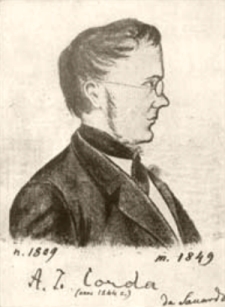August Carl Joseph Corda facts for kids
Quick facts for kids
August Carl Joseph Corda
|
|
|---|---|
 |
|
| Born | November 15, 1809 |
| Died | 1849 (aged 39-40) |
| Nationality | Czech |
| Occupation | Physician, mycologist |
August Carl Joseph Corda (1809–1849) was a Czech doctor and a scientist who studied fungi (a mycologist). He is known for his important work in botany, especially with fungi. When other scientists talk about plants or fungi he named, they often use the short name Corda.
Early Life and Learning
August Corda was born in a place called Reichenberg (which is now Liberec in the Czech Republic) on November 15, 1809. Sadly, both of his parents died when he was just a baby. His grandmother raised him, and he went to school in Reichenberg.
When he was 10, his grandmother also passed away. August then lived with a family he didn't know and didn't go to school for two years. Later, he moved to Prague to live with an uncle and attended a school called the "Lyceum of New Prague."
In 1824, because of family problems, August left the Lyceum. He then went to a polytechnical school. Here, he learned about many different subjects like physics, chemistry, and botany (the study of plants). He became very good at chemistry.
After school, August worked briefly in a chemical factory. Then he decided to study surgery at the University of Prague. During a time when many people were sick with cholera, he worked as an assistant surgeon. He helped sick people in several towns. But after a few years, he felt very tired from fighting the illness and stopped practicing medicine.
Discovering Fungi and Plants
After leaving medicine, August Corda went to Berlin for six weeks. He spent time with his friend Kurt Sprengel and other famous scientists like Alexander von Humboldt. This trip inspired him to study botany.
He was asked by the Berlin Academy to study how palms and similar plants grow. August enthusiastically wrote a book with almost 100 drawings about plant growth.
When he returned to Prague, August was invited to work at the Czech National Museum. He became the Curator of the Zoology Division. However, he quickly became most interested in the museum's collection of fungi. This became the main focus of his work.
August Corda is famous for his huge six-volume book called Icones fungorum hucusque cognitorum, which means "Illustrations of Fungi Known So Far." He also wrote Prachtflora europäischer Schimmelbildungen, about European molds. He was one of the first scientists to carefully measure the tiny spores of the fungi he described.
In 1848, during a time of political trouble in Prague, August Corda was suspected of being involved in political activities. He was almost harmed but managed to escape.
August Corda is still well-known to scientists who study fungi today. He discovered and described many important types of fungi, including one called Stachybotrys. Sadly, he died at sea in 1849 while returning home from a trip where he collected plant and fungi samples in Texas.
In 1851, a new group of fungi was named Cordana in his honor.
See also
 In Spanish: August Carl Joseph Corda para niños
In Spanish: August Carl Joseph Corda para niños

